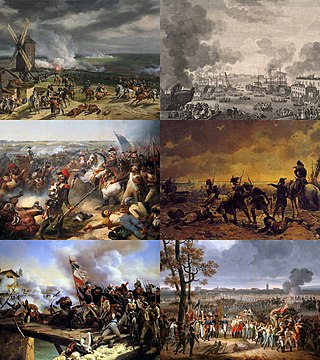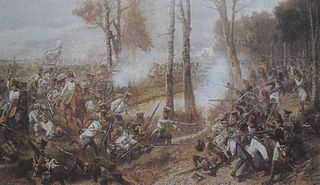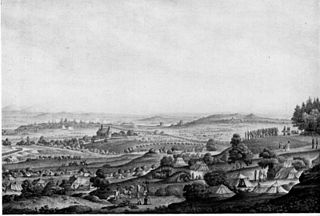
1814 (MDCCCXIV) was a common year starting on Saturday of the Gregorian calendar and a common year starting on Thursday of the Julian calendar, the 1814th year of the Common Era (CE) and Anno Domini (AD) designations, the 814th year of the 2nd millennium, the 14th year of the 19th century, and the 5th year of the 1810s decade. As of the start of 1814, the Gregorian calendar was 12 days ahead of the Julian calendar, which remained in localized use until 1923.

Jean-Andoche Junot, Duke of Abrantes was a French military officer who served in the French Revolutionary Wars and the Napoleonic Wars. He is best known for leading the French invasion of Portugal in 1807.

The War of the First Coalition was a set of wars that several European powers fought between 1792 and 1797, initially against the constitutional Kingdom of France and then the French Republic that succeeded it. They were only loosely allied and fought without much apparent coordination or agreement; each power had its eye on a different part of France it wanted to appropriate after a French defeat, which never occurred.

Louis Lazare Hoche was a French military leader of the French Revolutionary Wars. He won a victory over Royalist forces in Brittany. His surname is one of the names inscribed under the Arc de Triomphe, on Column 3. Richard Holmes describes him as "quick-thinking, stern, and ruthless... a general of real talent whose early death was a loss to France."

The Battle of Neerwinden saw a Republican French army led by Charles François Dumouriez attack a Coalition army commanded by Prince Josias of Saxe-Coburg-Saalfeld. The Coalition army of the Habsburg monarchy together with a small contingent of allied Dutch Republic troops repulsed all French assaults after bitter fighting and Dumouriez conceded defeat, withdrawing from the field. The French position in the Austrian Netherlands swiftly collapsed, ending the threat to the Dutch Republic and allowing Austria to regain control of its lost province. The War of the First Coalition engagement was fought at Neerwinden, located 57 kilometres (35 mi) east of Brussels in present-day Belgium.

The Hundred Days, also known as the War of the Seventh Coalition, marked the period between Napoleon's return from eleven months of exile on the island of Elba to Paris on 20 March 1815 and the second restoration of King Louis XVIII on 8 July 1815. This period saw the War of the Seventh Coalition, and includes the Waterloo Campaign and the Neapolitan War as well as several other minor campaigns. The phrase les Cent Jours was first used by the prefect of Paris, Gaspard, comte de Chabrol, in his speech welcoming the king back to Paris on 8 July.

The French Revolutionary Wars were a series of sweeping military conflicts resulting from the French Revolution that lasted from 1792 until 1802. They pitted France against Great Britain, Austria, Prussia, Russia, and several other countries. The wars are divided into two periods: the War of the First Coalition (1792–1797) and the War of the Second Coalition (1798–1802). Initially confined to Europe, the fighting gradually assumed a global dimension. After a decade of constant warfare and aggressive diplomacy, France had conquered territories in the Italian Peninsula, the Low Countries and the Rhineland. French success in these conflicts ensured the spread of revolutionary principles over much of Europe.
The French Revolutionary Wars began on 20 April 1792 when the French Legislative Assembly declared war on Austria. This launched the War of the First Coalition.

Emmanuel de Grouchy, marquis de Grouchy was a French military leader who served during the French Revolutionary Wars and the Napoleonic Wars. He was the last Marshal of the Empire to be created by Napoleon, and is best known for his actions during the Waterloo campaign.

The Imperial-Royal or Imperial Austrian Army was the armed force of the Habsburg monarchy under its last monarch, the Habsburg Emperor Francis II, composed of the Emperor's army. When the Holy Roman Empire was dissolved in 1806, it assumed its title of the troops of the Austrian Empire under the same monarch, now known as Emperor Francis I of Austria.

In the siege of Mainz, from 14 April to 23 July 1793, a coalition of Prussia, Austria, and other German states led by the Holy Roman Empire besieged and captured Mainz from revolutionary French forces. The allies, especially the Prussians, first tried negotiations, but this failed, and the bombardment of the city began on the night of 17 June.

The Army of Condé was a French field army during the French Revolutionary Wars. One of several émigré field armies, it was the only one to survive the War of the First Coalition; others had been formed by the Comte d'Artois and Mirabeau-Tonneau. The émigré armies were formed by aristocrats and nobles who had fled from the violence in France after the August Decrees. The army was commanded by Louis Joseph de Bourbon, Prince de Condé, the cousin of Louis XVI of France. Among its members were Condé's grandson, the Duc d'Enghien and the two sons of Louis XVI's younger brother, the Comte d'Artois, and so the army was sometimes also called the Princes' Army.
Jean Léchelle or Jean L'Échelle briefly commanded a French army during the French Revolutionary Wars. Having served in the French Royal Army as a youth, the outbreak of the French Revolution found him employed as a fencing master. He was elected to lead a volunteer National Guard battalion which fought at Valmy and Jemappes in 1792. He earned promotion to general officer after distinguishing himself at the Siege of Valenciennes and saving a representative from an angry mob. He won such favor with the politicians and the war office that he was rapidly catapulted into command of an army in the War in the Vendée. After the capable battalion leader demonstrated his total unfitness for the post of army commander, he was just as quickly arrested and thrown into prison where he died, a probable suicide.

The Low Countries theatre of the War of the First Coalition, in British historiography better known as the Flanders campaign, was a series of campaigns in the Low Countries conducted from 20 April 1792 to 7 June 1795 during the first years of the War of the First Coalition. As the French Revolution radicalised, the revolutionary National Convention and its predecessors broke the Catholic Church's power (1790), abolished the monarchy (1792) and even executed the deposed king Louis XVI of France (1793), vying to spread the Revolution beyond the new French Republic's borders, by violent means if necessary. The First Coalition, an alliance of reactionary states representing the Ancien Régime in Central and Western Europe – Habsburg Austria, Prussia, Great Britain, the Dutch Republic, Hanover and Hesse-Kassel – mobilised military forces along all the French frontiers, threatening to invade Revolutionary France and violently restore the monarchy. The subsequent combat operations along the French borders with the Low Countries and Germany became the primary theatre of the War of the First Coalition until March 1796, when Napoleon took over French command on the Italian front.

The Second Battle of Saorgio was fought from 24 to 28 April 1794 between a French First Republic army commanded by Pierre Jadart Dumerbion and the armies of the Kingdom of Sardinia-Piedmont and the Habsburg monarchy led by Joseph Nikolaus De Vins. It was part of a successful French offensive designed to capture strategic positions in the Maritime Alps and Ligurian Alps, and on the Mediterranean coast. Tactical control of the battle was exercised by André Masséna for the French and Michelangelo Alessandro Colli-Marchi for the Coalition. Saorge is located in France, about 70 kilometres (43 mi) northeast of Nice. At the time of the battle, the town was named Saorgio and belonged to Piedmont.

Jean René Moreaux commanded the French Army of the Moselle during the French Revolutionary Wars. He joined the French Royal Army in 1776 and was badly wounded in the American Revolutionary War two years later. After leaving military service, he married and took over the family business. At the time of the French Revolution he was elected second in command of a volunteer battalion. He was rapidly promoted, emerging as a general officer in May 1793. After another promotion, he led a corps at Pirmasens and a division at Wissembourg. He was appointed commander of the Army of the Moselle in June 1794. In November he was sent with three divisions to invest the fortress of Luxembourg. He caught a fever and died during the Siege of Luxembourg. His surname is one of the names inscribed under the Arc de Triomphe.

The siege of Condé saw a force made up of Habsburg Austrians and French Royalists commanded by Duke Ferdinand Frederick Augustus of Württemberg lay siege to a Republican French garrison led by Jean Nestor de Chancel. After a blockade lasting about three months the French surrendered the fortress. The operation took place during the War of the First Coalition, part of a larger conflict known as the French Revolutionary Wars. Condé-sur-l'Escaut, France is located near the Belgium border about 14 kilometres (9 mi) northeast of Valenciennes.

The siege of Mainz was a short engagement at the beginning of the War of the First Coalition. The victorious French army of Custine seized the town on October 21, 1792, after three days of siege. The French occupied Mainz, and tried to install the Republic of Mainz there.

The siege of Maastricht was a failed siege of the city of Maastricht by the forces of the French First Republic from 6 February to 2 March 1793, marking the final action of the 1793 campaign of the War of the First Coalition. The city was successfully defended by the Dutch garrison with the assistance of a small band of French Royalists.

Georges-Louis-Félix, baron de Wimpffen or Wimpfen was a French general of the Revolutionary and Napoleonic Wars.



















